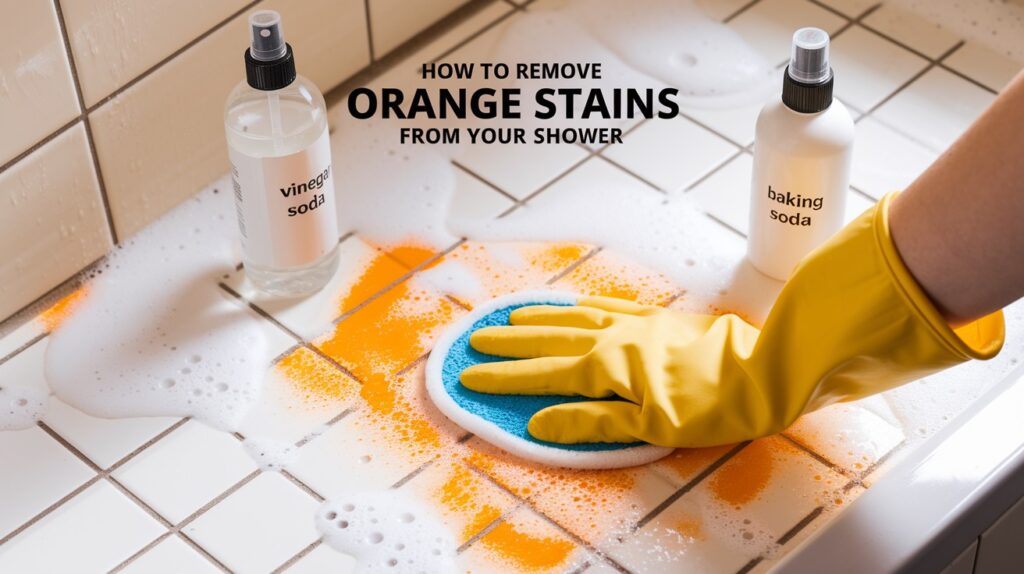Those stubborn orange stains in your shower aren’t just ugly, but they’re a real problem. These discolored spots usually come from iron in your water supply or a mix of soap scum and hard water minerals that build up over time.
If you’ve been scrubbing without success, you’re not alone. Many homeowners struggle with these persistent stains that make even a clean bathroom look dirty.
This guide breaks down simple, proven methods to remove orange stains using common household items. You’ll learn why these stains form, what works best to clean them, and how to prevent them from coming back.
We’ve tested these solutions in real homes with real stain problems. No fancy products needed, just effective techniques that work.
By the end of this article, you’ll have your shower looking spotless again and know exactly how to keep it that way.
What Causes Orange Stains in the Shower?
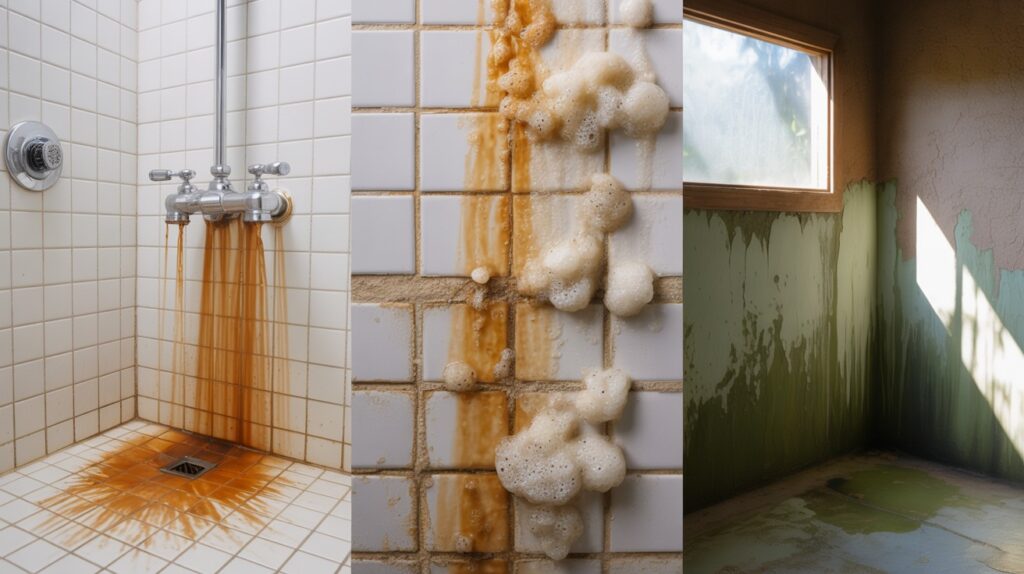
Understanding why these stains appear helps you fight them more effectively. Three main culprits create those unsightly orange marks.
Iron in Your Water Supply
If you have well water, iron is likely your biggest problem. Even city water can contain iron, but well water typically has much higher levels.
When iron-rich water sits on surfaces and dries, it leaves behind rusty orange deposits. These stains start small but grow darker and more stubborn over time.
Easy test: Fill a clear glass with your tap water and let it sit for an hour. If you see orange sediment at the bottom, iron is present.
Hard Water Plus Soap Equals Trouble
Hard water contains high levels of calcium and magnesium minerals. When these minerals mix with soap, they create a sticky film that clings to shower surfaces.
This soap scum acts like glue for other particles in your water. Dirt, dead skin cells, and yes the iron particles, because all stick to this film and create orange buildup.
The warmer your shower water, the faster this process happens. Heat speeds up mineral deposits.
Mold and Mildew Growth
Bathrooms are naturally humid spaces. When moisture combines with soap residue and mineral deposits, it creates perfect conditions for mold and mildew.
Some types of mold appear orange or rust-colored, especially in their early stages. This organic growth often mixes with mineral stains, making the problem look worse.
Key point: What looks like one big stain problem is usually several issues layered together. That’s why you need multiple cleaning steps to get everything clean.
Tools and Materials You’ll Need
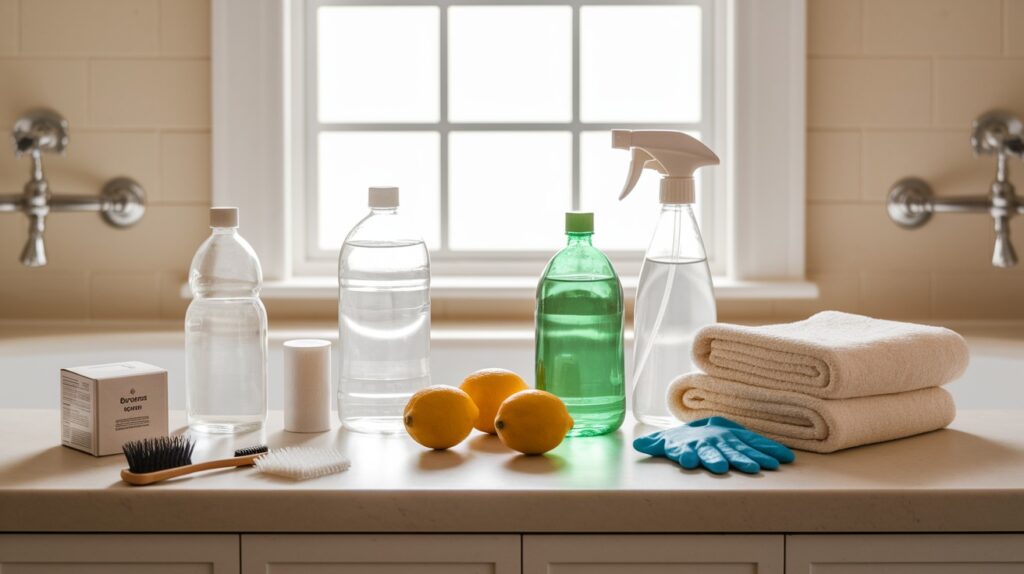
You probably have most of these items in your kitchen and bathroom already. No expensive specialty cleaners required.
- White vinegar
- Baking soda
- Hydrogen peroxide
- Lemon juice
- Spray bottle
- An old toothbrush or scrub brush
- Microfiber cloths
- Gloves for protection
Step-by-Step Cleaning Methods
A simple guide that breaks down effective cleaning techniques into easy steps. This section shows you exactly how to remove tough stains using common household items, with clear timing and instructions for each method.
Step 1: Initial Rinse and Prep
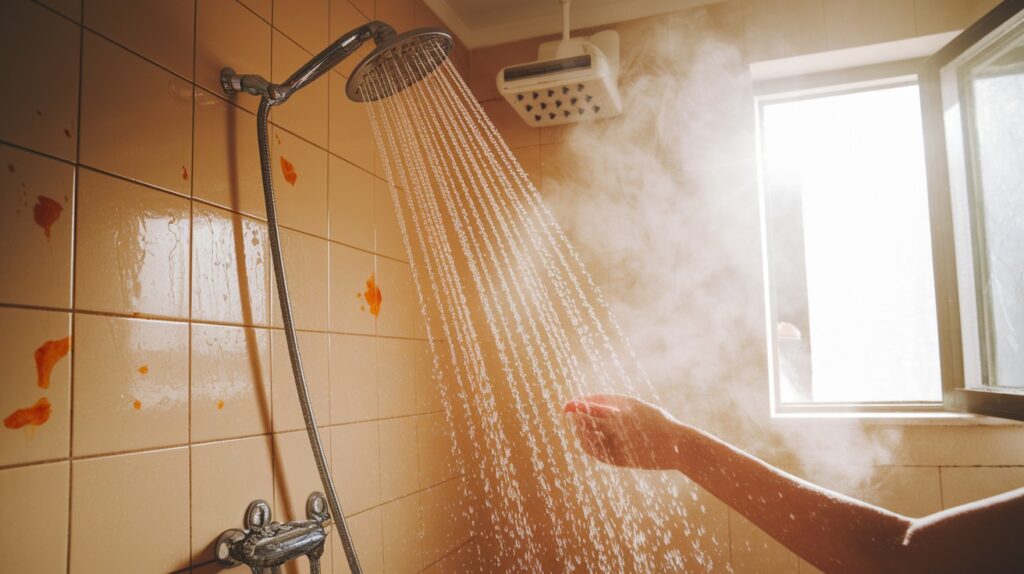
Start by turning on your shower and letting warm water run over the stained areas for about 30 seconds. This softens built-up grime and makes the cleaning process easier.
Open your bathroom window or turn on the exhaust fan. Good airflow protects you from cleaning fumes and helps everything dry faster.
Quick tip: Remove any bottles or items from the shower area first. You need clear access to work effectively.
Step 2: Use Vinegar Spray

Fill a spray bottle with plain white vinegar—no diluting needed. The acid in vinegar breaks down mineral deposits naturally.
Spray the orange stains until they’re completely wet. Don’t hold back here. More coverage means better results.
Set a timer for 15 minutes and walk away. I know it’s tempting to start scrubbing right away, but patience pays off. The vinegar needs time to work its magic on those stubborn deposits.
Step 3: Scrub with Baking Soda
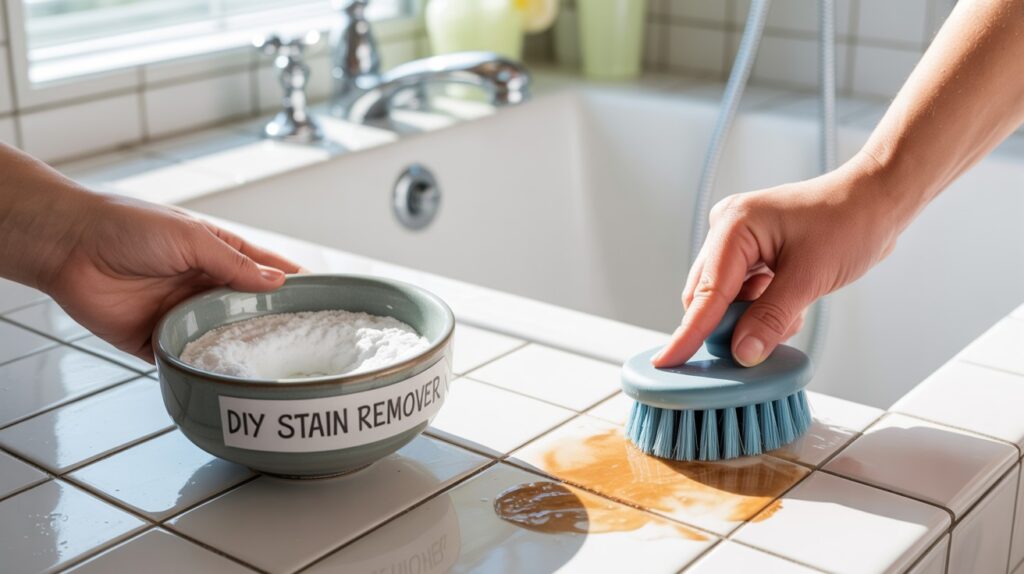
Mix three parts baking soda with one part water in a small bowl. You want a thick paste that won’t run off vertical surfaces.
Apply the paste directly to the stained areas using your fingers or a spoon. Then, grab an old toothbrush or soft scrub brush.
Scrub in circular motions with moderate pressure. The baking soda acts like gentle sandpaper while the vinegar continues breaking down minerals.
Here’s what you’ll notice: The paste will start changing color as it lifts the stains. That’s exactly what you want to see.
Step 4: Apply Hydrogen Peroxide
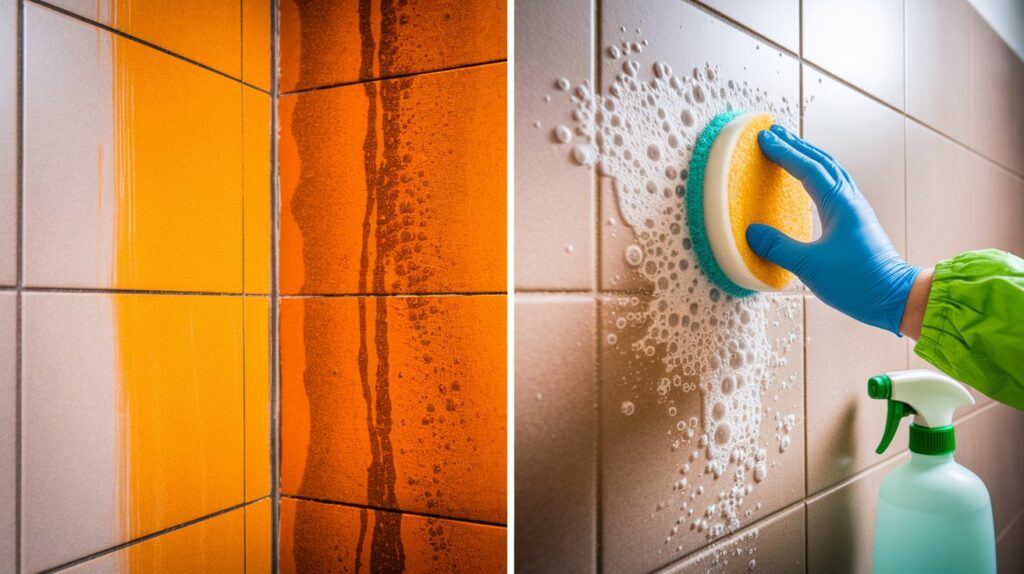
Some stains won’t budge with vinegar and baking soda alone. That’s when hydrogen peroxide saves the day.
Pour a small amount directly on the worst spots. You’ll see it bubble and foam becaue this reaction is lifting deep-set stains from the surface.
Wait 2-3 minutes for the bubbling to slow down. Then scrub these areas again with your brush. The combination of all three ingredients tackles even the toughest buildup.
Step 5: Rinse and Wipe Dry
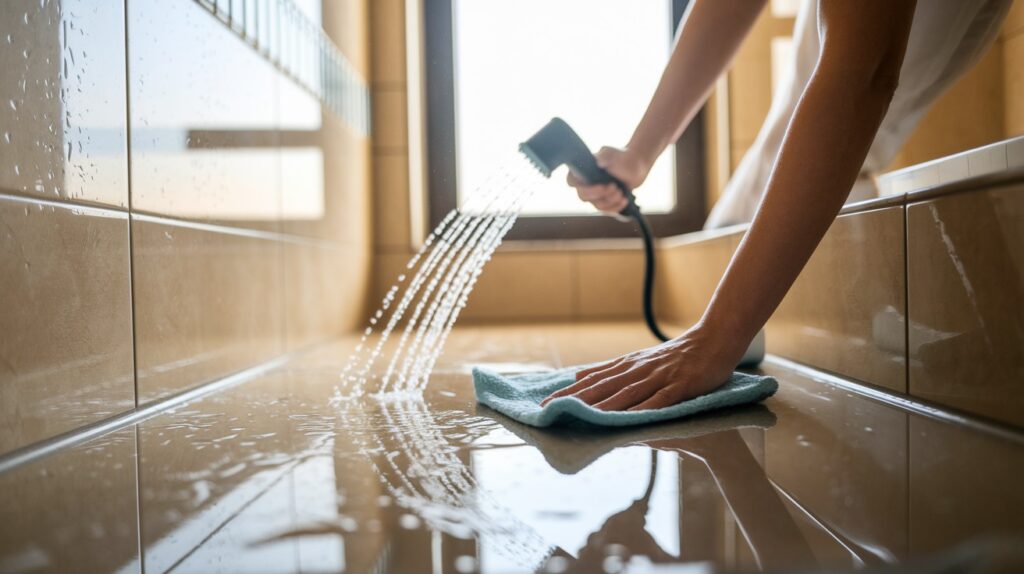
Turn your shower back on and rinse everything thoroughly. Make sure you wash away all cleaning residue, because leftover products can attract new dirt.
Here’s the critical final step most people skip: dry the surfaces completely with a microfiber cloth.
Water spots become tomorrow’s stains. By wiping dry, you prevent new mineral deposits from forming while your shower is still perfectly clean.
Pro move: Keep that microfiber cloth handy for quick daily wipe-downs after each shower.
Natural Alternatives for Tough Stains
When basic cleaning doesn’t work, try these stronger natural options.
Lemon Juice and Salt Combo:
- Cut a lemon in half. Sprinkle salt on the cut side.
- Rub it directly on orange stains.
- The acid cuts through minerals while salt scrubs them away.
- Let it sit for 10 minutes, then rinse clean.
Borax Paste:
- Mix borax powder with water to make a thick paste.
- Spread it on stains and wait 20 minutes. Scrub with a brush and rinse.
- Borax works great on soap scum and mineral buildup. Wear gloves when using it.
Commercial Rust Removers: Use these only if natural methods fail.
Safety rules:
- Wear gloves and eye protection
- Open windows for air flow
- Never mix with other cleaners
- Follow the bottle instructions exactly
These products contain strong acids. They work, but can damage surfaces if used wrong. Try natural methods first. Most orange stains come off without harsh chemicals.
Preventing Future Orange Stains
- Install a water softener for hard water. Add an iron filter if you have well water.
- Wipe down shower walls after each use. Use a towel or squeegee to remove water droplets.
- Spray surfaces with white vinegar once a week. Rinse clean to stop mineral buildup.
- Keep metal items out of the shower. Shaving cream cans and razors can rust and stain surfaces.
- Use liquid soap instead of bar soap. This reduces soap scum formation.
- Run the exhaust fan during showers. Keep it on for 30 minutes after to reduce humidity.
- Clean your showerhead monthly. Soak it in vinegar to prevent iron and mineral clogs.
- Replace old caulk if it’s stained or cracked. Old caulk traps moisture and minerals.
Conclusion
Orange stains don’t have to be permanent fixtures in your shower. With the right approach, you can remove even stubborn buildup using simple household items.
Start with the basic vinegar and baking soda method. Most stains will come off with this combination. For tougher spots, try lemon and salt or borax paste before reaching for commercial products.
Remember that prevention is easier than cleaning. Wipe down your shower after use and do a quick vinegar spray weekly. These small habits save hours of scrubbing later.
Your shower can look clean and fresh again. The methods in this guide work because they target the root causes of orange stains—iron, minerals, and soap buildup.
Try these techniques and see the difference for yourself. A spotless shower is just a few cleaning sessions away.
Frequently Asked Questions
How often should I clean orange stains from my shower?
Clean them as soon as you notice them forming. Weekly vinegar sprays prevent most buildup. Deep cleaning every 2-3 weeks keeps stains from getting stubborn.
Can I use bleach on orange stains?
Bleach doesn’t work on mineral stains. It only whitens organic stains like mold. Stick to acids like vinegar or lemon juice for iron and mineral deposits.
Why do my orange stains keep coming back so quickly?
Your water likely has high iron or mineral content. Consider installing a water softener or iron filter. Without treating the source, stains will return within days.
Is it safe to mix vinegar with other cleaning products?
Never mix vinegar with bleach or hydrogen peroxide at the same time. Use one method, rinse completely, then try another if needed. Mixing can create dangerous fumes.
Will these methods damage my shower tiles or fixtures?
Vinegar and baking soda are safe for most surfaces. Test any new cleaner in a small, hidden area first. Avoid abrasive scrubbing on delicate finishes like natural stone.

